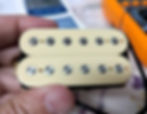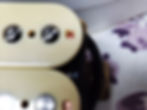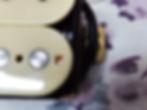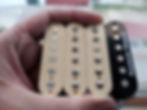Donlis DH-53 Review
- Barış Şahin
- May 17, 2024
- 7 min read
Updated: Dec 30, 2024
The undeniable fact is that China, as the powerhouse of global production, is continuously elevating its level in the guitar industry. I remember the guitars produced in the Far East (such as Korea and China, etc.) in the '90s, they were cheap, but honestly, they weren't great guitars. The guitars I experienced were either as heavy as dead weight or unnervingly light. Their common feature, with few exceptions, was a general lack of quality. Now, when I look at the guitars finding or carving out a place for themselves in the market today... Some of them are so good that you can buy them and, if needed, change the strings and record an album with their stock condition; they are good enough not to break the bank when purchasing them. In many of them, roasted maple necks, stainless steel frets, locking tuners, relatively high-quality nuts, solid wood bodies, impeccably smooth finishes and final specs that are incomparable to what we used to have are included. Of course, there are still some shortcomings, especially in terms of craftsmanship, but looking at today compared to the recent past, I believe we can set our expectations very high for tomorrow. It would have been unthinkable for the development in the guitar itself not to be reflected in the guitar components as well. Donlis has been one of the standout companies on AliExpress recently when it comes to pickups. Based on what I've read and data-driven analyses, I wanted to purchase and test one of their products to see if what we've heard is true, or how much of it is true...
Test Guitar
Donlis DH-53 i have purchased was in the neck of my hand-made superstrat that has a Turkish alder body, a Q-sawn one-piece maple neck in a chunky Endur-Neck profile, Gotoh 510T-FE1 tremolo, 25.5” scale, steel frets, Bourns 500K pots, and 009-042 Elixir strings in E-standard tuning. The guitar has a Mojotone ’59 Clone Hot bridge and Dimarzio Cruiser middle pickups. Its primary (unplugged) tone ranges from balanced to medium-bright.
Evaluation
I don't know who manufactures these pickups. Besides brands like Donlis, Saphue, and Fleor, there are many unnamed AliExpress brands available. I'm unsure if all of them have the same manufacturer or if these companies produce their own pickups. I don't know if Donlis or its manufacturer produces pickups for Western companies like Tonerider or Iron Gear, which also have production in China. However, considering the level of pickups I've come across in my circle, I wonder about the quality of the pickup I acquired. There are noticeable similarities in the products of the brands I mentioned, and overall, I believe the quality is relatively high considering their price. Let me start by presenting the technical measurements and detailed photographs of the pickup first.
Donlis DH-53 Neck
Magnet – Alnico 5
Advertised DCR: 7,20 K Ohm (Series)
Measured DCR: 7,44 K Ohm (Series)
Measured DCR: 3,74 K Ohm (Screw Coil)
Measured DCR: 3,71 K Ohm (Slug Coil)
Inductance @100Hz: 4,04 H (Series)
Inductance @100Hz: 1,71 H (Screw Coil)
Inductance @100Hz: 1,80 H (Slug Coil)
Measured C: -38,3 nF (Series)/ -71,3nF (Screw Coil) / -75nF (Slug Coil)
Output: Moderate
Gauss: 300G slug, 285G screw (measured at top center of pole pieces)
Did my measurements ring a bell for you? They did for me. So, if I were to copy and paste the table I previously published for you to compare, would you be able to recognize this 'famous' humbucker? And in your opinion, how similar could they be in terms of tonality?
Magnet – Alnico 5
Measured DCR: 7,28 K Ohm (Series)
Measured DCR: 3,64 K Ohm (Screw Coil)
Measured DCR: 3,64 K Ohm (Slug Coil)
Inductance @100Hz: 4,09H (Series)
Inductance @100Hz: 1,71 H (Screw Coil)
Inductance @100Hz: 1,84 H (Slug Coil)
Measured C: -40 nF (Series)/ 75,3nF (Screw Coil) / -77,6nF (Slug Coil)
Gauss: 380G slug, 330G screw
If we consider the measurements and photos, DH-53 have symmetrical coils just like the ‘famous’ one. They both feature polished Alnico 5 magnets. The inductance values are almost identical. As individual coils, they also have very close resistance and inductance values. The magnetic flux density values are also not significantly different. Measuring capacitance in this way isn't the right method for obtaining correct data because when discussing guitar pickups, we should be talking about data in the picofarad (pF) range, not nanofarads (nF). However, I am taking and publishing these values for comparative purposes. I've noticed that the capacitance values are quite parallel as well.
As many of you have already figured out, the pickup I compared it to was the Seymour Duncan Jazz. DH-53 can easily be said to be a copy of the Jazz in terms of technical measurements.
Moving on to the tonal evaluation, the fundamental qualities I described for the Duncan Jazz, which you can read more about in my review, apply to the DH-53 to a large extent as well. DH-53 is indeed a very clear neck humbucker. It's quite successful in terms of articulation, clear and distinct. Just like the Jazz, it's not so much a "single-ish humbucker" but more like a "humbucker-ish single." It has bass but not fancy, the mids are somewhat lacking, but the high frequencies are lively. The output is also moderate. I can truly summarize DH-53 as a "Poor man's Jazz.
Differences between the original Jazz and the DH-53, if any, are minimal in my opinion, considering that I haven't conducted an A-B test for evaluation. I can say on a large scale that they are very much alike. I felt the same as I did with the Jazz. At the nuanced level, the portion of the wound strings after the 12th fret felt slightly boomier compared to the Jazz. However, if I had installed a Jazz pickup on this guitar, would I have felt the same? I'm not sure, but the Jazz is already installed on one of my guitars, which has a slightly warmer tone, and after the 12th fret, the feeling of boominess in the wound strings is slightly less pronounced. Perhaps I'll try my DH-53 with an Alnico 4 magnet or degauss the magnet inside it...
DH-53 is very articulate humbucker. You won’t have compression problems with it. But remember, the lack of mids may get your tones less-meaty on the leads and does not help to cutting the mix as well. I’ve written on my Jazz review; “Seymour designed Jazz for a purpose. He wanted a brother for his JB to match its power and mid growl along with brilliant neck tones. That’s what Jazz is. It is very dynamic and bright. Say farewell to the boominess and mud”. I can spend the very same words for DH-53, too.
As for the split tone, I can say that I'm not a fan. Generally, I'm not a big fan of coil splits in pickups with <8K output, but I much prefer the coil-split feature on pickups on the neck like the Pearly Gates (b), PAF Pro, or Al DiMeola neck. I don't particularly like it on the Jazz either; that's why I prefer parallel wiring over coil splitting for it, and that would be my recommendation to you as well.
Slug and screw diameters seem slightly narrower and shorter than those of the Jazz. Moreover the thickness of the baseplate felt a bit thinner. I measured and compared them with a Pearly Gates neck. Here they are:
Donlis Screw Lengh: 20.65mm, thread dia. 2.91mm, head dia. 4.95mm
Pearly Gates Lengh: 21.90mm, thread dia. 3,03mm, head dia. 4.94mm
Donlis Baseplate thickness: 0,71mm approx.
Pearly Gates Baseplate thickness: 0,80mm approx.
Another difference from the Jazz is the brass baseplate. As you know, the Jazz has a nickel silver baseplate, but the DH-53 has brass. If you ask me if there's any difference, I haven't heard of any. And honestly, after the measurements presented by the researcher known as Antigua, I don't believe the baseplate makes any difference.
Next thing you like to know is the color of the bobbin. It is different than the cream of dimarzio (cream of dimarzio is a bit yellow/orange-ish compared to Donlis or Duncan) but very close to Seymour Duncan. Not the very same but close enough to me. The only thing i can say as a difference is Donlis seems a tiny bit more transluscent.
One thing i didn’t like much about DH-53 is the “craftsmanship” that i had mentioned in the begining of my artcile; level of built quality. When you demount the pickup you can see something you wouldn’t like to see. A knurled surface of the magnet, not perfectly manteled parts or not properly applied paper tape etc. Generally speaking, most those faults are unaudible. BUT!!! When you consider its price, not minding them is easier.
Conclusion
There are positive and negative aspects to mention about the DH-53. According to my measurements and experience, the DH-53 is a complete copy of the Jazz pickup. It's a very good copy. So much so that if you don't have the budget for an original Seymour Duncan Jazz or you're curious about Jazz but not sure if you'll like it and don’t want to risk your Money, or you don't intend to buy an original SD and instead like to have cheap but quality humbucker or at least you have a dream of a Jazz humbucker in double cream color, then I would say go for it. The risk is minimal for the price you pay. It's really fortunate to have such a quality pickup at this price point. On the other hand, the potential of being able to produce pickups like this without branding and remaining as copies of time proven pickup designs could create a stagnant cycle.
Honestly, I don't plan to get rid of my DH-53, and I'll keep it for its potential in different projects. Furthermore, the DH-53 has piqued my curiosity to try out other Donlis models. Hopefully, in the near future, I'll have the opportunity to try out different models.
Guitar pickup reviews


































